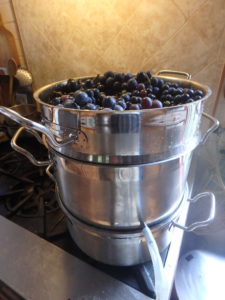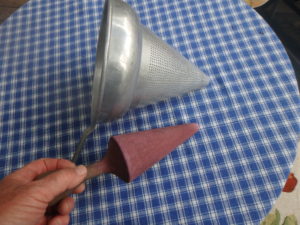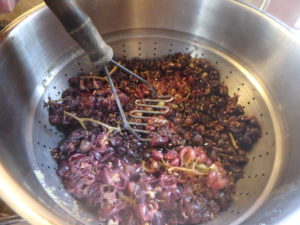Easy Ways to Get and Store Juice from Your Fruit
For me, this has been a banner year for grapes. I have just a couple of plants, but they are large and vigorous. They are the Concord type with big seeds. I know one is a ‘Purple Valiant’, but the other name is long forgotten. They are quite tart for fresh eating, and the birds seem to enjoy them more than I do, so they get most of them. Not this year. I had enough to make some juice, and a neighbor gave me even more.
Six years ago I bought a NorPro brand “Steamer/Juicer” while visiting friends in Seattle, Washington. The salesperson had convinced me it would be great for making all kinds of fruit juices, plus, it was on sale! But until recently, I never did much with it.
The juicer consists of 3 parts, all heavy duty stainless steel: an 8.5-quart water pot, which sits on the stove burner and produces steam. Fitting into that is a 4-quart juice catcher with a volcano-shaped opening in the middle that sends steam into the fruit basket sitting above it, and catches the juice that drips down. Finally, on top, is an 11 quart fruit basket that is full of holes. And of course there is a nice glass lid.
It works like this: First, wash the fruit and remove any bad fruit. Bring water to a boil in the water pot, then place the juice catcher on top of that. The juice catcher has a drainage pipe attached, and a hose with a clamp on it, allowing you to easily drain off the juice. The steam passes up through the juice catcher and into the fruit basket, cooks the fruit and releases the juices. Each batch of grapes makes 3 to 4 quarts of grape juice.
Previously I had made grape and elderberry juice with something called a jelly cone. This is a V-shaped metal cone full of holes like a colander. To make juice, I removed the stems and cooked the berries until they are a mush. It comes with a V-shaped wooden pusher that is used to squeeze the cooked fruit against the sides of the cone. That releases the juice while most of the pulp stays in the cone.
It sounds easy to use, but is actually quite messy and tedious. To make elderberry juice, for example, each elderberry has a tiny stem that must be separated from the berry. The nice thing about the steamer/juicer is that you can leave all the stems on.
Another way to make juice is to use a muslin jelly bag and hand squeeze the cooked berries to get the juices out. I gather that it is messy, but effective. I see that commercially made jelly bags are available on-line if you don’t want to make one.
In addition to grapes, I used my steamer/juicer to make juice from crabapples. I have one crabapple tree that produces large fruit – up to an inch and a half in diameter – with nice wine-red skins and tasty fruit. So I picked 150 of them and used them to make one batch of juice in my steamer. I cut each apple in half before steaming to facilitate juice production. The result was a nice pink, mild-flavored apple juice. I got nearly a gallon of juice.
I made over 4 gallons of juices and obviously could not drink it all before it would begin to ferment. What did I do? I could have canned it in glass jars in a hot water bath. According to the video I watched, 5 to 10 minutes fully submerged in a boiling pot of water would preserve it for storage on a shelf. But that’s a lot of work, too.
Instead of canning the juice, I decided to freeze it. I went to my local apple orchard/cider producer and bought half gallon plastic jugs with snap-on lids. I decanted my juice from the steamer into half gallon glass bottles when hot, and allowed it to cool. Plastic is not suitable for boiling or very hot liquids.
After it cooled I poured the juice into the plastic jugs for freezing. I left at least an inch and a half of air space at the top of each jug so that when the juice froze and expanded it would not push off the lid and spill into my freezer. Half gallon jugs just fit on the door of my freezer.
Making grape or elderberry juice is a job for old clothes, dark-colored ones, as the juice will stain as badly as red wine. I put down a thick layer of newspaper over the wooden countertop in case I spilled any.
I love eating something I grew every day of the year. I store, dry and freeze all kinds of fruits and vegetables. Making juices allows me to expand my list of foods available in winter. It takes a lot of time to prep everything, but I know that the food I put up is chemical free, too, which is important to me.
Join me on a Viking River Cruise from Paris to Normandy and back next June. Just e-mail me for information: henry.homeyer@comcast.net.





